Discover 35 hidden attractions, cool sights, and unusual things to do in Bergen (Norway). Don't miss out on these must-see attractions: Bryggen, Fløyen, and Gamlehaugen. Also, be sure to include Bergenhus Fortress in your itinerary.
Below, you can find the list of the most amazing places you should visit in Bergen (Hordaland).
Table of Contents
Bryggen
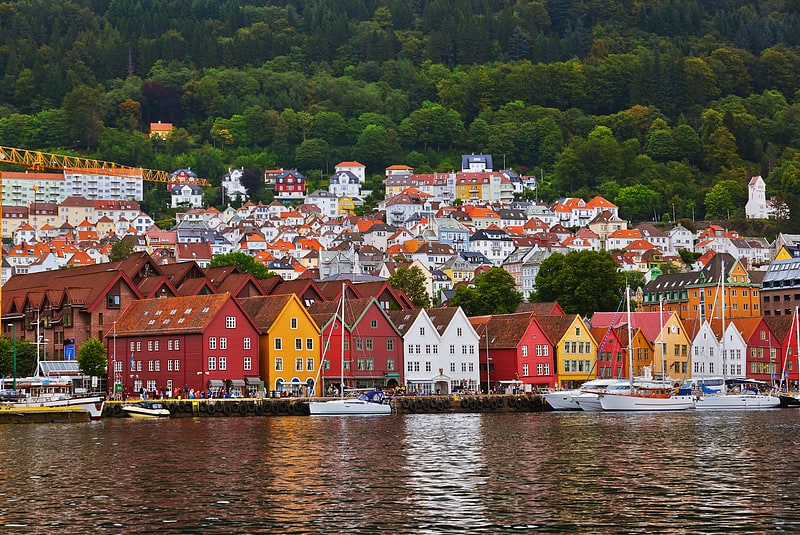
Old wharf and traditional wooden buildings. Bryggen, also known as Tyskebryggen, is a series of Hanseatic heritage commercial buildings lining up the eastern side of the Vågen harbour in the city of Bergen, Norway. Bryggen has been on the UNESCO list for World Cultural Heritage sites since 1979.
The city of Bergen was founded around 1070 within the boundaries of Tyskebryggen. Around 1350 a Kontor of the Hanseatic League was established there, and Tyskebryggen became the centre of the Hanseatic commercial activities in Norway. Today, Bryggen houses museums, shops, restaurants and pubs.[1]
Address: Bryggen 45, 5003 Bergen (Bergenhus)
Fløyen
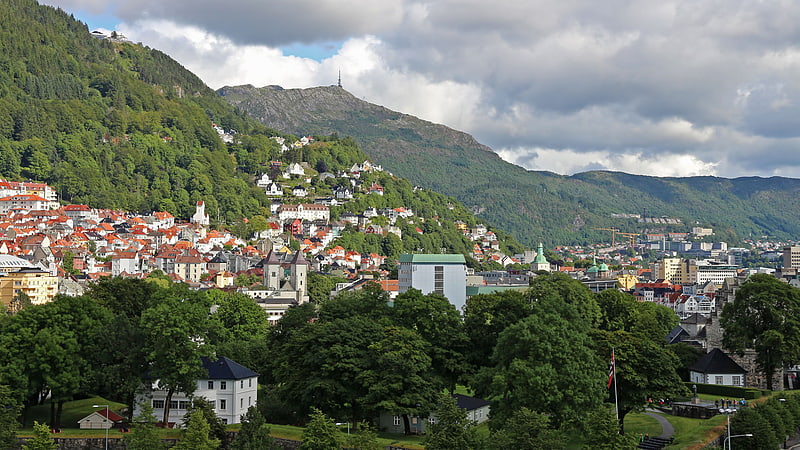
Also known as: Fløyfjellet
Mountain with a funicular and hiking paths. Fløyen or Fløyfjellet is one of the "city mountains" in Bergen, Hordaland, Norway. Its highest point is 400 m above sea level. The name could originate from fløystangen or a weather vane that was set up to indicate the direction of the wind for sailing ships. The view of the Bergen peninsula makes Fløyfjellet a popular attraction among tourists and locals alike. It has a funicular system called Fløibanen that transports passengers from the center of Bergen to a height of 320 m in roughly eight minutes.[2]
Address: Fløyfjellet 2, Bergen (Bergenhus)
Gamlehaugen
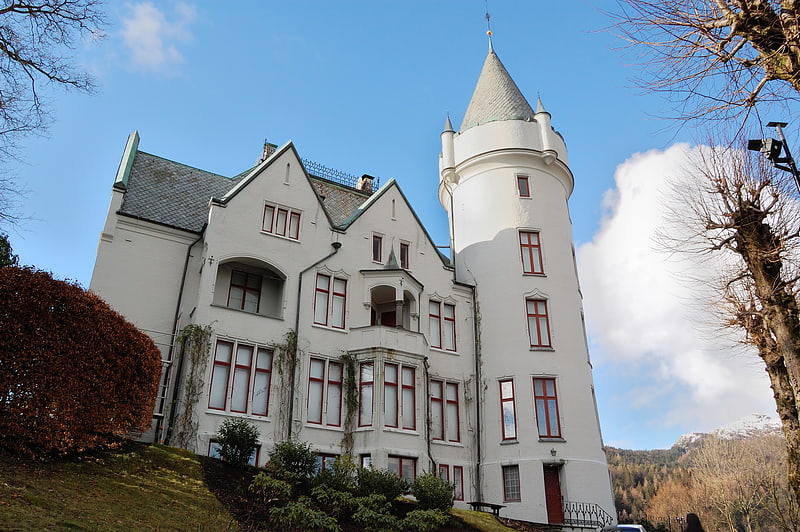
Historic castle with a park and swimming. Gamlehaugen is a Royal Castle in Bergen, Norway, and the residence of the Norwegian Royal Family in the city. Gamlehaugen has a history that goes as far back as the Middle Ages, and the list of previous owners includes many of the wealthiest men in Bergen. Today owned by the Norwegian state, the most recent private owner was Christian Michelsen, a politician and shipping magnate who later became the first Prime Minister of Norway after the dissolution of the union between Sweden and Norway. Michelsen commissioned the construction of the current main building at Gamlehaugen, where he would live for most of the rest of his life.
When Michelsen died in 1925, his closest friends and colleagues started a national fund-raising campaign that brought in enough money to allow the Norwegian state to purchase the property. The large English park was opened to the public the same year, and the ground floor of the house was opened as a museum two years later. Gamlehaugen has been the Norwegian Royal Family's residence in Bergen since 1927.[3]
Address: Gamlehaugveien 10, Bergen (Fana)
Bergenhus Fortress
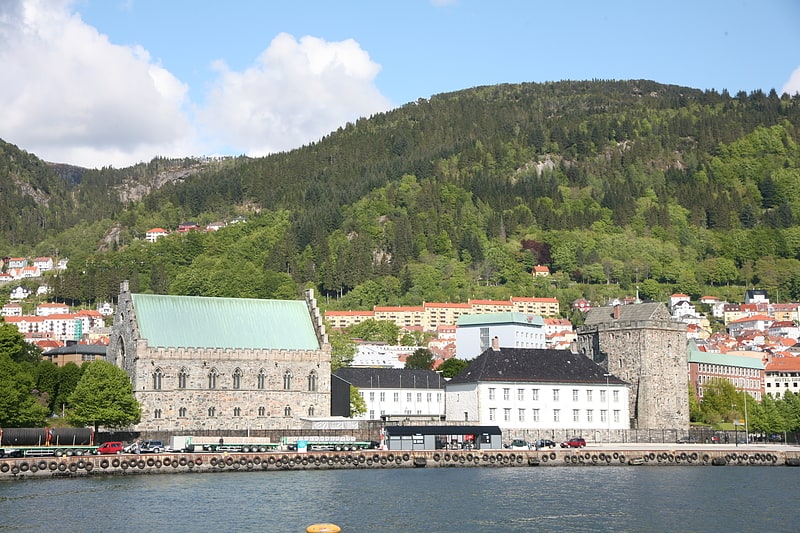
Also known as: Bergenhus festning
Harborside stone fortress and museum. Bergenhus fortress is a fortress located in Bergen, Norway. Located at the entrance of Bergen harbour, the castle is one of the oldest and best preserved stone fortifications in Norway.[4]
Address: Bergenhus 4, Bergen (Bergenhus)
Troldhaugen
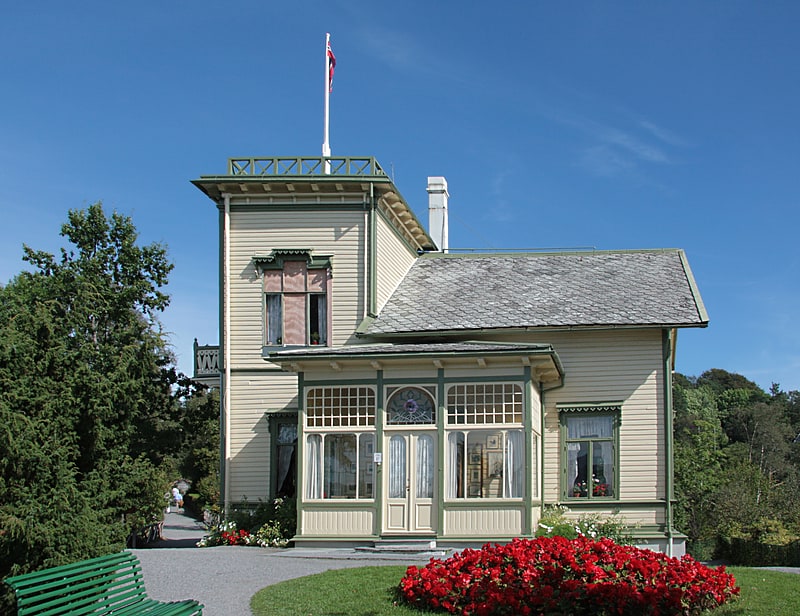
Museum detailing composer's life and work. Troldhaugen is the former home of Norwegian composer Edvard Grieg and his wife Nina Grieg. Troldhaugen is located in Bergen, Norway and consists of the Edvard Grieg Museum, Grieg's villa, the hut where he composed music, and his and his wife's gravesite.[5]
Address: Troldhaugvegen 65, 5232 Bergen (Fana)
Bergen Aquarium
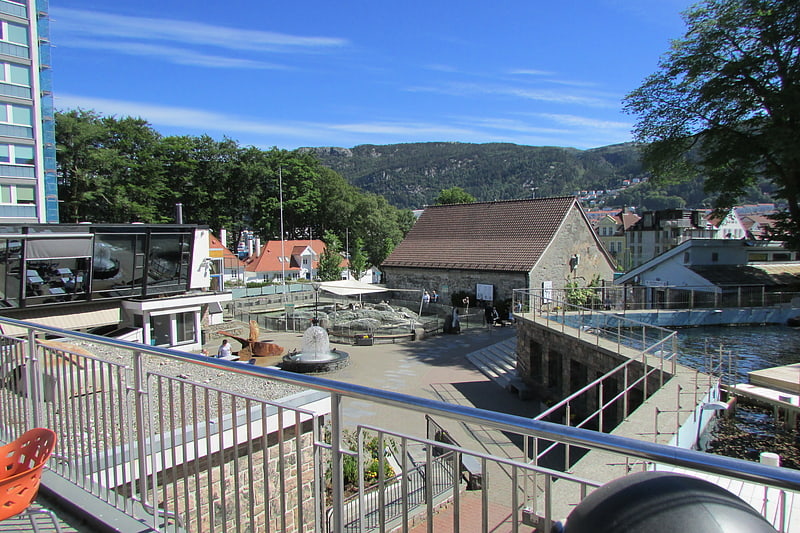
Also known as: Akvariet i Bergen
Aquarium with sea lion shows and penguins. Bergen Aquarium is a public aquarium in Bergen, Norway. It is situated on the Nordnes peninsula and is one of Bergen's tourist attractions.[6]
Address: Nordnesbakken 4, 5005 Bergen (Bergenhus)
Fantoft Stave Church
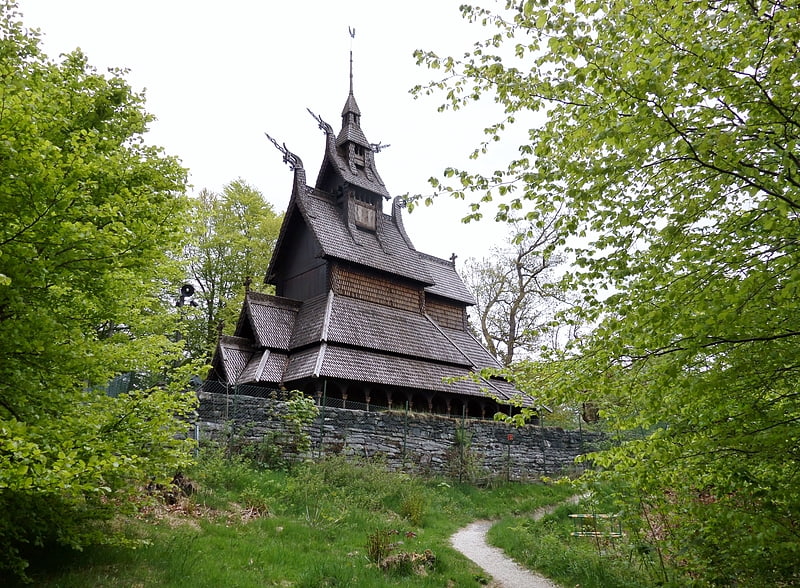
Also known as: Fantoft stavkirke
Ornate wooden church dating from 1150. Fantoft Stave Church is a reconstructed stave church in the Fana borough of the city of Bergen, Norway.[7]
Address: Fantoftvegen 38, 5072 Bergen (Fana)
St Mary's Church
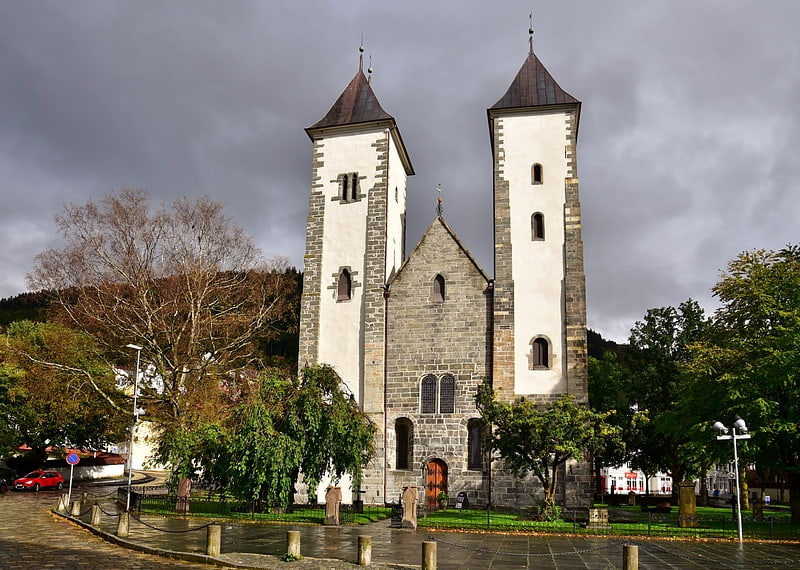
Also known as: Mariakirken i Bergen
Historic church built in the 1100s. St Mary's Church is a parish church of the Church of Norway in Bergen Municipality in Vestland county, Norway. It is located in the Bryggen area in the central part of the city of Bergen. It is one of the churches for the Bergen Cathedral parish which is part of the Bergen domprosti in the Diocese of Bjørgvin. The large, gray stone church was built in a long church design using plans drawn up by an unknown architect. The church seats about 240 people. The construction of the church is believed to have started in the 1130s or 1140s and completed around 1180, making this church the oldest remaining building in the whole city of Bergen. There have been a few fires that burned the church, as well as several renovations and reconstructions, most recently in 2013.[8]
Address: Dreggsallmenningen 15, 5003 Bergen (Bergenhus)
Bergen Cathedral
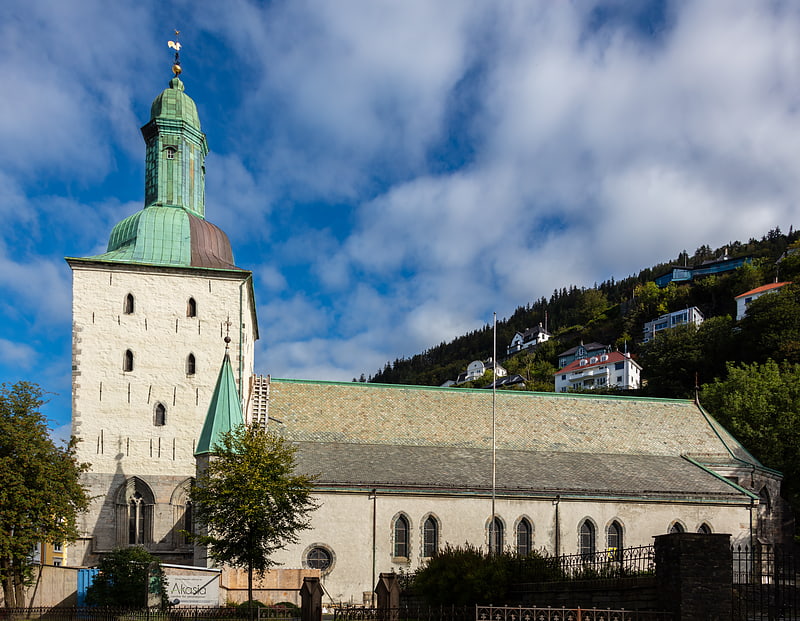
Also known as: Bergen domkirke
Centuries-old landmark with a clocktower. Bergen Cathedral is a cathedral in the city of Bergen in Vestland county, Norway. It is the episcopal seat of the Diocese of Bjørgvin as well as the seat of the "Bergen domkirke" parish and the seat of the Bergen domprosti. It is part of the Church of Norway. The first recorded historical reference to this church is dated 1181. It retains its ancient dedication to Saint Olaf. The cathedral seats about 900 people.[9]
Address: Kong Oscargate and Domkirkegate, Bergen (Bergenhus)
St John's Church
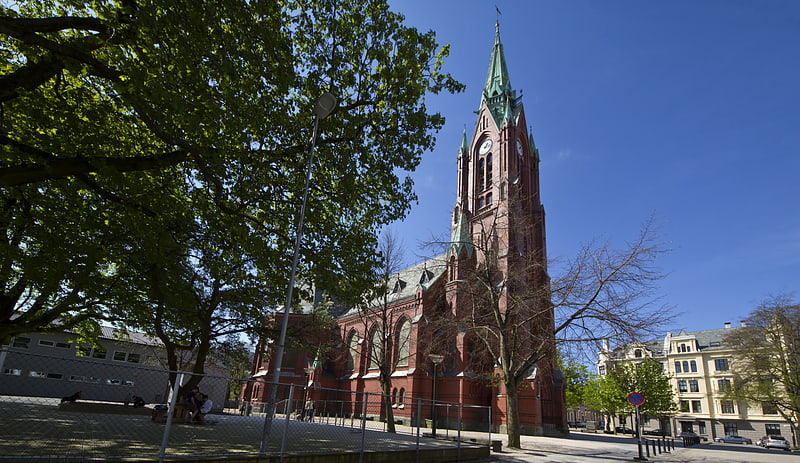
Also known as: Johanneskirken
Large Catholic church made of brick. St. John's Church is a parish church of the Church of Norway in Bergen Municipality in Vestland county, Norway. It is located in the Sydnes area of the city of Bergen. It is one of the five churches for the Bergen Cathedral parish which is part of the Bergen domprosti in the Diocese of Bjørgvin. The red brick church was built in a cruciform design between 1891 and 1894 in the Gothic Revival style. The architect was Herman Backer. The church seats about 1250 people, making it the largest church in Bergen. It was consecrated on 15 March 1894.[10]
Address: Sydnesplassen 5, 5007 Bergen (Bergenhus)
Lille Lungegårdsvannet

Lake in Norway. Lille Lungegårdsvannet or Smålungeren is a small 5 acres lake in the centre of the city of Bergen in Vestland county, Norway. The octagonal lake is a natural lake that was historically connected to the nearby Store Lungegårdsvannet bay via a short strait, but the strait was filled in 1926. Today the lake is located in a park in the city centre. There is a large decorative fountain located in the central part of the lake.[11]
Address: Lille Lungegårdsvannet, 5015 Bergen (Bergenhus)
Bergen Technical Museum

Also known as: Bergens Tekniske Museum
Museum in Bergen, Norway. Bergen Technical Museum is a technical museum located at Møhlenpris in Bergen, Norway. It is owned and run by various local membership groups with each their own specialized collections, which is collectively displayed in an old tram depot.
The museum is the starting place and acts as a depot for Bergen's Electric Tramway, which runs a heritage tramway service. The collections also include the two old funicular cars from Fløibanen and one of four preserved NSB Di 2 locomotives.[12]
Address: 23 Thormøhlens Gate, Bergen (Bergenhus)
KODE
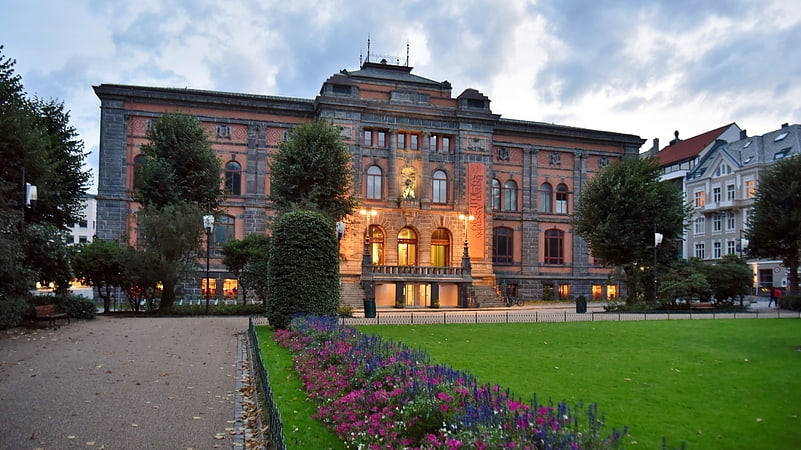
Museum in Bergen, Norway. The West Norway Museum of Decorative Art was established in 1887 at the initiative of Johan Bøgh. In 1896 the museum moved into a permanent exhibition building, a Renaissance Revival structure designed by Henry Bucher. The building caught fire during the 1916 Bergen fire but was saved.
The collections include older local works in silver, furniture, glass, porcelain, and textiles. Upon its opening, the museum received substantial donations from the merchant Christian Sundt.
During the first years, the Bergen Art Gallery occupied the top floor. The collection was then moved from there to the former power plant building after it became available. The Fisheries Museum also occupied the ground floor.
After merging with Bergen Art Museum, the museum has been a venue for more temporary exhibitions. Its emphasis remains on crafts from the past 500 years, and also its Chinese Collection, a unique assembly of Chinese art. This is mostly a bequest from Johan Wilhelm Normann Munthe, who lived in China from age 22 until his death in 1935.
The museum was also responsible for the Alvøen site and Damsgård Manor, but this has now been taken over by the new Bergen City Museum.[13]
Address: Rasmus Meyers Allé 9, 5015 Bergen (Bergenhus)
Grieg Hall
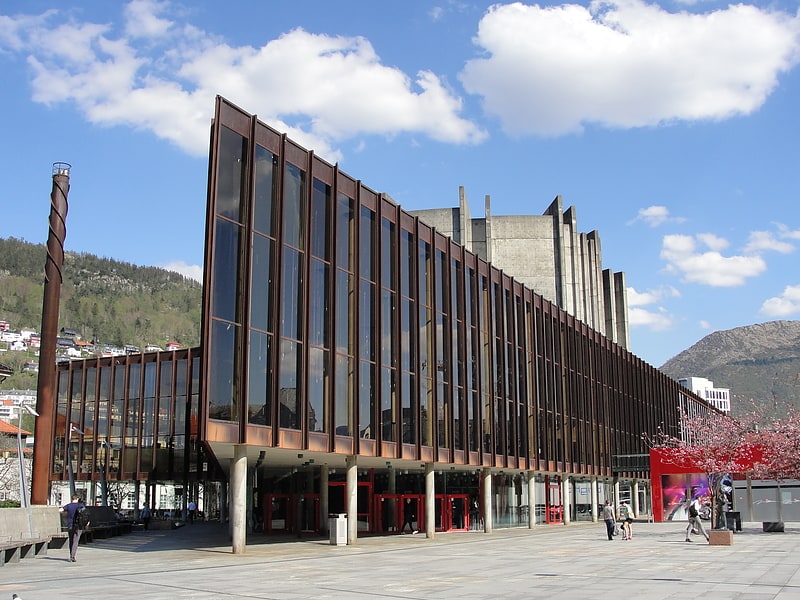
Also known as: Grieghallen
Concert hall in Bergen, Norway. Grieg Hall is a 1,500 seat concert hall located on Edvard Griegs' square in Bergen, Norway.
Grieghallen was named in honor of Bergen-born composer Edvard Grieg, who served as music director of the Bergen Philharmonic Orchestra from 1880 until 1882. It serves as the home of the Bergen Philharmonic Orchestra. The building was designed in modernist architecture style by the Danish architect Knud Munk. Construction began in 1967 and was finished by May 1978.[14]
Damsgård Manor
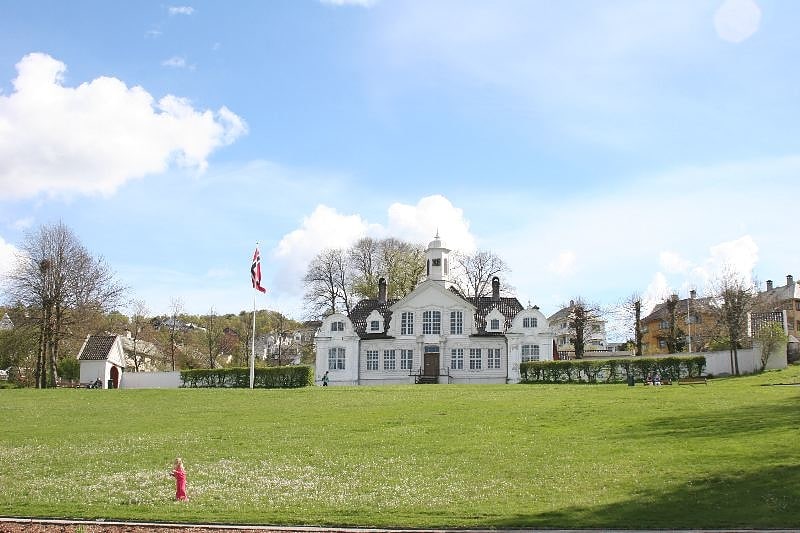
Also known as: Damsgård hovedgård
Guided tours of a 1700s landmark. Damsgård Manor is a landmark manor and estate in Bergen, Norway. It is noted for its distinct rococo style and is possibly the best preserved wooden building from 18th-century Europe.[15]
Address: Alléen 29, 5160 Laksevåg, Bergen (Laksevåg)
Puddefjorden
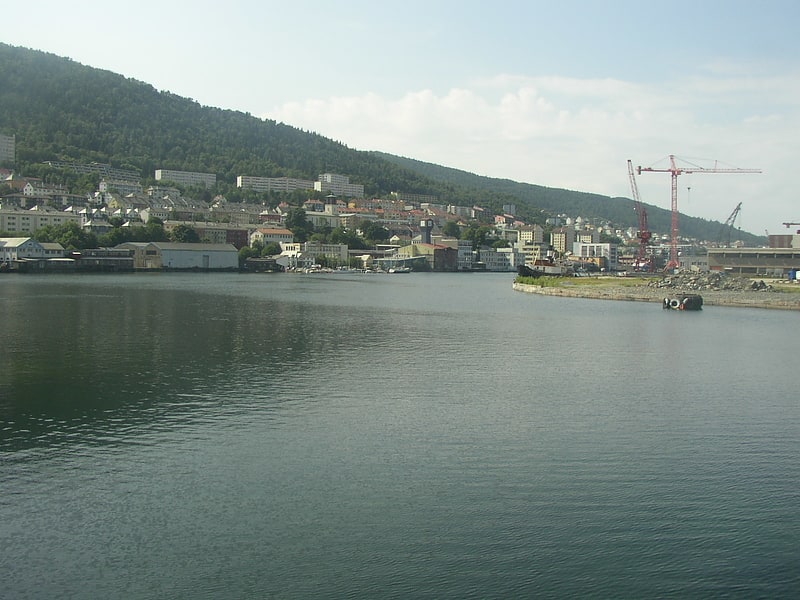
Puddefjorden, often anglicized as Pudde Fjord, is an inlet or fjord in the central part of the city of Bergen in Vestland county, Norway. An arm off of the main Byfjorden, the Puddefjorden is 3.5 kilometres long and stretches from the tip of the Nordnes peninsula to the Solheimsviken bay at the entrance to the Store Lungegårdsvannet bay. The fjord is 1.2 kilometres at its widest, between Nordnes and the inner part of the borough of Laksevåg. The innermost part of the fjord, known as Damsgårdssundet, is much narrower, scarcely 100 metres wide at its narrowest. The fjord is located next to some of Bergen's most important industrial areas, and has played a significant part in the city's development and industrialisation.[16]
Korskirken
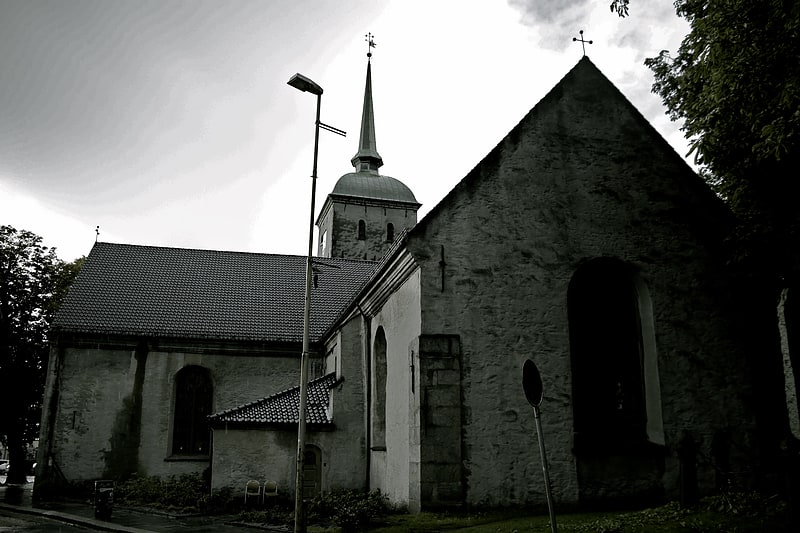
Church in Bergen, Norway. Holy Cross Church is a special parish church in Bergen municipality in Vestland county, Norway. It is situated in the centre of the city of Bergen, just east of the head of the Vågen bay. The church is located at the intersection of the streets Kong Oscars gate and Nedre Korskirkeallmenning. It is one of the churches for the Bergen domprosti parish which is part of the Bergen domprosti in the Diocese of Bjørgvin. The large stone church was built in a cruciform design around the year 1150 using plans drawn up by an unknown architect. The church seats about 600 people.[17]
Address: Nedre Korskirkeallmenningen 20, 5017 Bergen (Bergenhus)
University Museum of Bergen
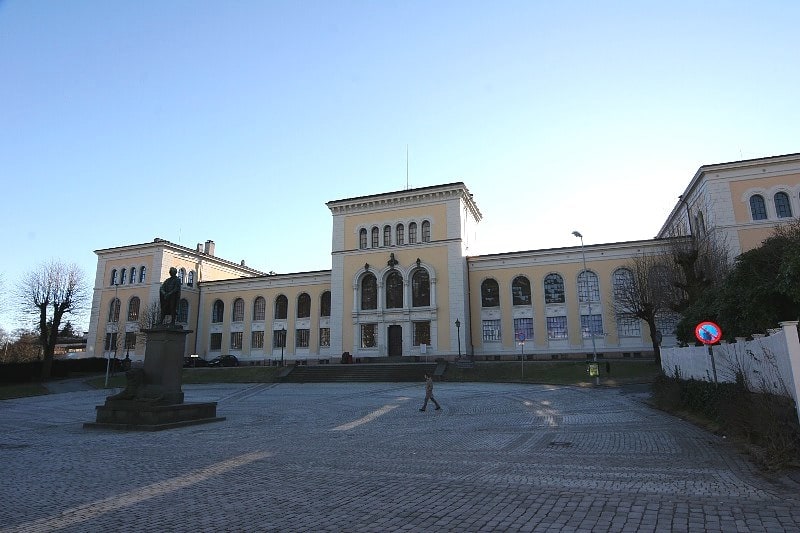
Also known as: Universitetsmuseet i Bergen
Museum in Bergen, Norway. The University Museum of Bergen is a university museum in Bergen, Norway. The museum features material related to anthropology, archaeology, botany, geology, zoology, art, and cultural history.[18]
Address: Muséplass 3, Bergen (Bergenhus)
Askøy Bridge
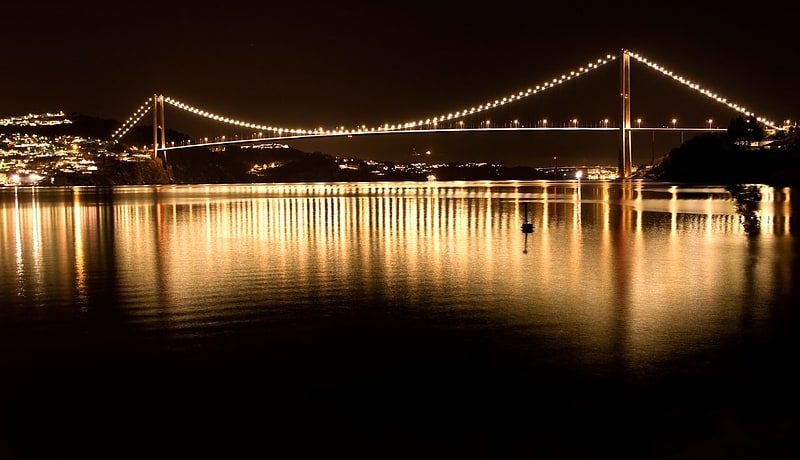
Also known as: Askøybrua
Suspension bridge in Norway. The Askøy Bridge is a suspension bridge that crosses the Byfjorden between the municipalities of Bergen and Askøy in Vestland county, Norway. It is 1,057 meters long and has a main span of 850 meters. Its span was the longest for any suspension bridge in Norway, until the Hardanger Bridge was opened in August 2013. It carries two lanes of County Road 562 and a combined pedestrian and bicycle path. The bridge's two concrete pylons are 152 meters tall and are located at Brøstadneset in Bergen municipality and Storeklubben in Askøy municipality. The bridge has seven spans in total, although all but the main span are concrete viaducts. The bridge has a clearance below of 62 meters.
The first plans to replace the Kleppestø–Nøstet Ferry with a bridge, which would allow the island of Askøy to have a fixed link, was launched in the 1960s. Various proposals were made, including placing the bridge further east and closer to Bergen, and building a submerged floating tunnel. In the early 1970s, a toll company was established to finance the bridge, but the planned costs were too high to cover with just tolls and there was the lack of a motorway to Bergen from the west. Because of this, the construction of the bridge was postponed. In the early 1980s, there was controversy about whether advanced tolls should be charged on the ferry, but these were ultimately charged from 1984 until the bridge opened. Construction started in 1989 and the bridge opened ahead of schedule on 12 December 1992, along with a new section of the road which included the Stongafjell Tunnel and Olsvik Tunnel. The bridge remained a toll road until 2006.[19]
Bryggens Museum
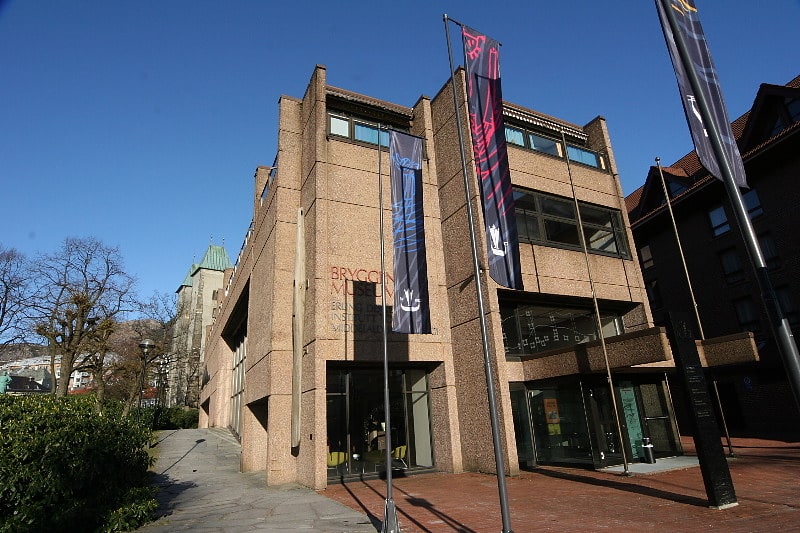
Museum in Bergen, Norway. Bryggens Museum is a museum located in Bergen, Norway.
During 1955, parts of the historic district of Bryggen were ravaged by a fire. During subsequent archaeological excavations a number of objects were uncovered, providing an insight into commerce, shipping, handicrafts and everyday life during the Medieval Period. Many of these artifacts now form the basis of the modern museum and are permanently exhibited. Additionally, the museum also has changing exhibits.
Bryggens Museum was established during 1976. The architect behind the design work was Øivind Maurseth, who also designed the nearby Radisson SAS Hotel. Archeologist Asbjørn Herteig was the first curator at the Bryggen Museum. Bryggens Museum has been part of Bergen City Museum since 2005.[20]
Address: Dreggsallmenningen 3, 5003 Bergen (Bergenhus)
Schøtstuene
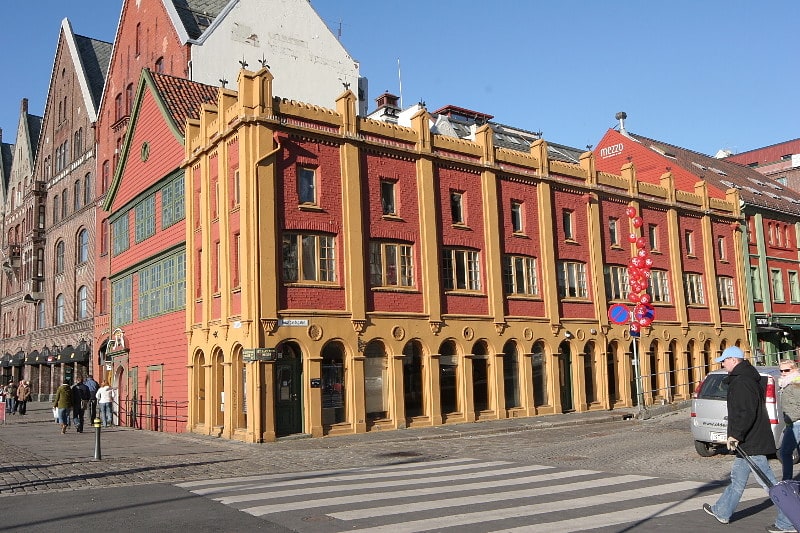
Museum in Bergen, Norway. Hanseatic Museum and Schøtstuene is a museum in the city of Bergen, Norway.[21]
Address: Øvregaten 50, Bergen (Bergenhus)
Carte Blanche

Carte Blanche is the Norwegian national company of contemporary dance, based in Bergen in western Norway. Since August 2018 the artistic and general director of the company has been Annabelle Bonnéry from France. Choreographers who have recently worked with Carte Blanche include Ina Christel Johannessen, Alan Lucien Øyen, Sharon Eyal, and Rui Horta.
The company produces a minimum of three new choreographic works a year and performs an average of four to six productions every year. While the home base of the company is in Bergen, the company spends much time touring elsewhere in Norway, but also abroad. Some recent international performances include:
- "Klokka 3 om ettermiddagen" by Ina Christel Johannessen at the "Ice hot – Nordic dance platform" festival in Stockholm, Sweden,
- "Corps de Walk" by Sharon Eyal in Turku, Finland, as a part of city's activities as a European Capital of Culture in 2011
- "Ambra" by Ina Christel Johannessen, a co-production between Carte Blanche and Iceland Dance Company staged at the Reykjavík Arts Festival and the Bergen International Festival. Johannessen received the 2008 Norwegian Critics Price for her choreography of Ambra.
- "Killer Pig" and "Love" by Sharon Eyal at the Jacob's Pillow Dance Festival, Becket, MA, USA
The company has an international crew of about 15 dancers. During the audition in January 2011, 170 candidates representing 28 nationalities were competing for two vacancies.
The history of Carte Blanche in Bergen starts in 1989, first as a regional dance theatre. After a turbulent start including a bankruptcy, the company has gained a solid position, and is currently the national contemporary dance theatre of Norway. Carte Blanche is owned and funded by the Norwegian state, the County of Hordaland and the City of Bergen.[22]
Address: Nøstegaten 119, Bergen (Bergenhus)
Nordnes Park
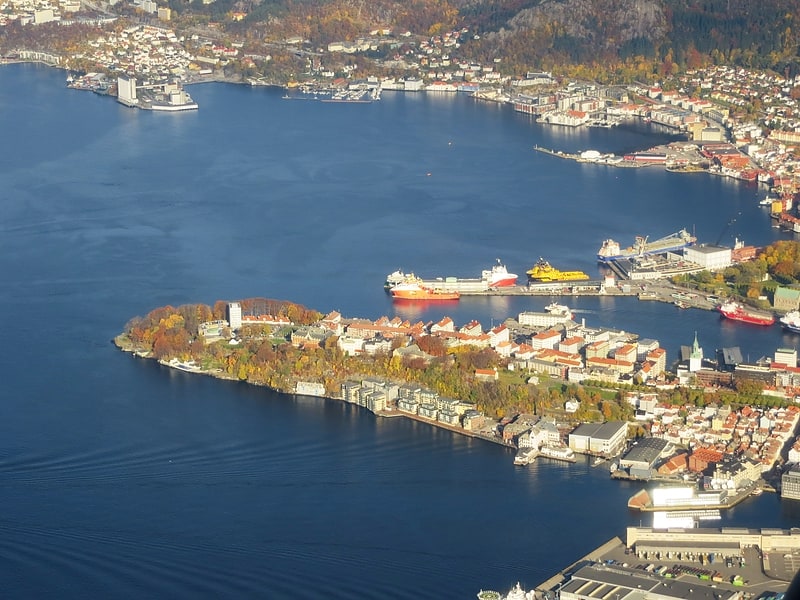
Also known as: Nordnesparken
Park in Bergen, Norway. The Nordnes Park is a public park in the municipality of Bergen in Vestland county, Norway. The park is located near the centre of the city of Bergen on the northwestern end of the Nordnes peninsula. It was established in 1888-1898 after an initiative from Edvard G. Johannessen in Det nyttige Selskab. The park covers about 32.7 decares of land.
The Bergen Aquarium and the headquarters of the Norwegian Institute of Marine Research are both located on the grounds of the park.
The city of Bergen and the city of Seattle are sister cities, and in 1970, Seattle sent a totem pole to Bergen to celebrate the city's 900th anniversary. The totem pole was erected in the Nordnes Park.[23]
Address: Nordnesparken 30, 5005 Bergen (Bergenhus)
Den Nationale Scene

Theatre in Bergen, Norway. Den Nationale Scene is the largest theatre in Bergen, Norway. Den Nationale Scene is also one of the oldest permanent theatres in Norway.[24]
Address: Engen 1, 5011 Bergen (Bergenhus)
Laksevåg Church

Also known as: Laksevåg kirke
Laksevåg Church is a parish church of the Church of Norway in Bergen Municipality in Vestland county, Norway. It is located in the borough of Laksevåg in the city of Bergen. It is the church for the Laksevåg parish which is part of the Bergen domprosti in the Diocese of Bjørgvin. The white, wooden church was built in a long church design in 1875 using plans drawn up by the architects Peter Andreas Blix and Theodor August Fromholz. The church seats about 432 people.[25]
Nykirken
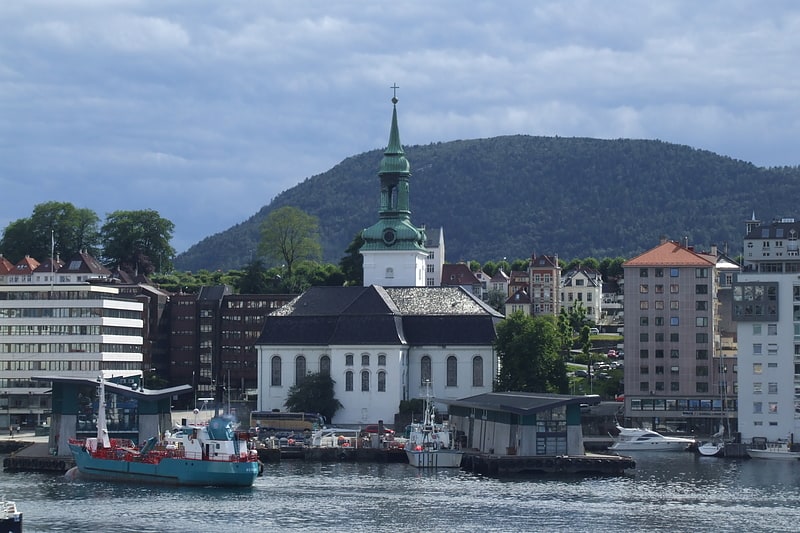
Church in Bergen, Norway. Nykirken is a parish church of the Church of Norway in Bergen Municipality in Vestland county, Norway. It is located in the Nordnes area of the city of Bergen. It is one of the churches for the Bergen Cathedral parish which is part of the Bergen domprosti in the Diocese of Bjørgvin.
The large, white, stone, cruciform church is located at the "Nykirkeallmenningen" square between the Strandgaten road and Vågen bay. Although it is generally known as the Nykirken, it was consecrated in 1622 by Bishop Nils Paaske as "Holy Trinity Church". When the church was originally built in 1622, there were several other churches in Bergen that were already several hundred years old, so this church was nicknamed "the new church", a name which has stuck for centuries. It is also (probably) an appropriate nickname, since the churches on this site have burned down several times and then been rebuilt, so it literally is usually the "newest" church in the central city. The current building dates back to 1764 when it was completely rebuilt and redesigned after a major fire. It has been significantly rebuilt several times since then, too, following various fires.
The church was a parish church for the Nykirken parish in central Bergen from 1622 until 2002. In 2002, several urban parishes in central Bergen were merged to form Bergen Cathedral parish. The Nykirken is still in regular use, but it has been given a special emphasis as a "children's church", putting a special emphasis on children and their families. Since 2002, the parish has started calling the church the "Children's Cathedral".[26]
Address: Strandgaten 197B, 5004 Bergen (Bergenhus)
Løvstakken
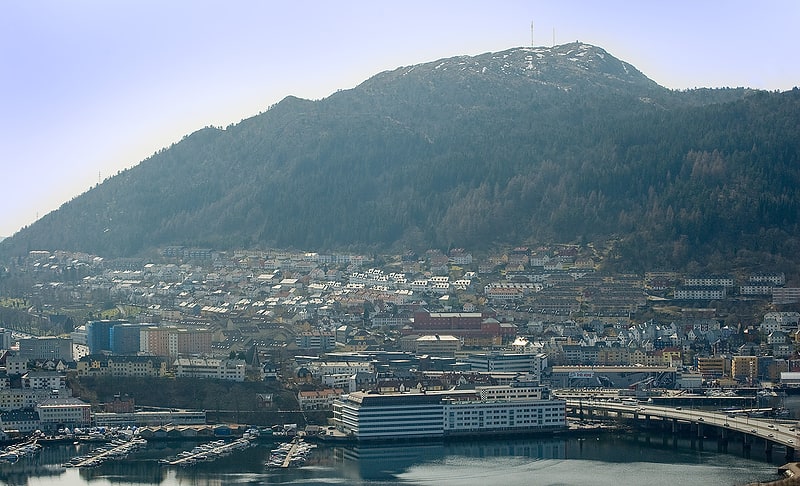
Mountain in Norway. Løvstakken is one of the Seven Mountains that surround the center of the city of Bergen in Vestland county, Norway. The 477-metre tall mountain is located between the Fyllingsdalen and Bergensdalen valleys on the Bergen Peninsula. Løvstakken and the forests nearby are popular hiking areas among the locals since it is essentially located in the central area of Norway's second largest city. Gullsteinen, a large hill located south of the summit of Løvstakken, is also part of the mountain massif and borders the protected forest area of Langeskogen.
The neighbourhood of Løvstakksiden in Årstad borough, north of the summit, is named after the mountain. The neighborhood was historically a borough of Bergen, but it has more recently dissolved and its areas were merged with Årstad and Fyllingsdalen boroughs.[27]
Store Lungegårdsvannet

Bay in Norway. Store Lungegårdsvannet is a bay located in the city and municipality of Bergen in Vestland county, Norway. The bay separates the city centre, located in the borough of Bergenhus, from the southern boroughs of the city, Årstad, Fana and Ytrebygda. The bay is situated at the end of the Puddefjorden.[28]
Address: Store Lungegårdsvannet, 5009 Bergen (Bergenhus)
Brann Stadion

Stadium in Bergen, Norway. Brann Stadion is a football stadium in Bergen, Norway. It was constructed in 1919, and has been the home of the football club Brann ever since. The stadium lies 3 km south of the city centre, at the foot of Mount Ulriken.
The record attendance dates from 1 October 1961, when Brann hosted Fredrikstad in the cup semi-final, in front of 24,800 spectators. Though its league attendance record is 23,900, from 1978, when they hosted Lillestrøm. Brann Stadion has, per. 2009, a capacity of 17,317. A redevelopment project was underway, aimed at increasing the capacity to over 20,000, but it has been put on hold. Brann Stadion has the third largest attendance capacity in Norway.
Brann Stadion was owned jointly by Brann (49%) and Stor-Bergen Boligbyggelag (51%). However, in an act of local-patriotism the Stor-Bergen Boligbyggelag sold its shares to Brann for the same sum they bought the shares for, despite the added value of the stadium as a result of the still ongoing reconstruction (December 2006).[29]
Address: Kniksens Plass 1, 5063 Bergen (Bergenhus)
St George's Church
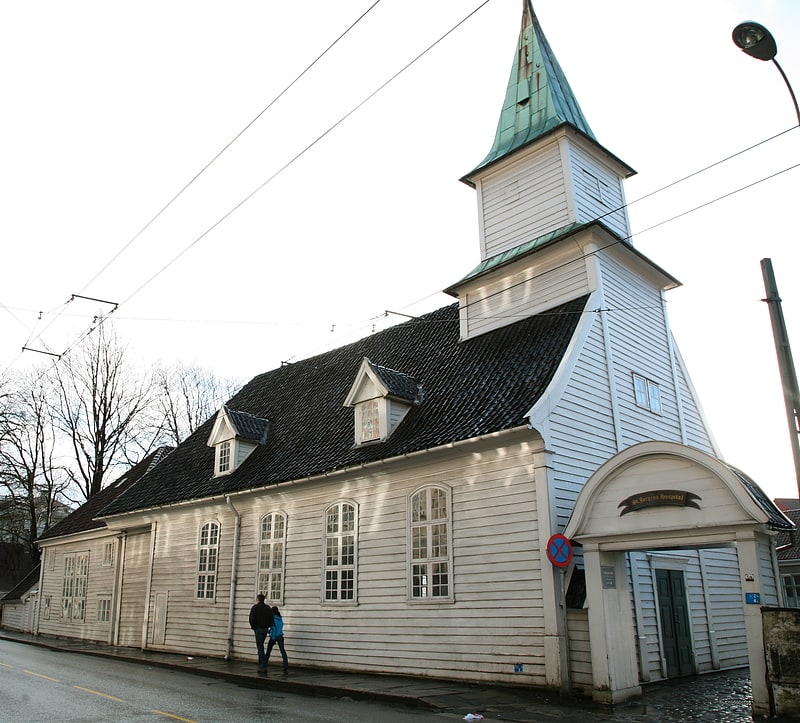
Also known as: Sankt Jørgen kirke
St George's Church, Bergen is a historic church of the Church of Norway in Bergen Municipality in Vestland county, Norway. This is also the site of the Leprosy Museum. Although it is no longer regularly used, it is one of the churches in the Bergen domprosti parish which is part of the Bergen domprosti in the Diocese of Bjørgvin. The green, wooden church was built in a cruciform design in 1706 using plans drawn up by an unknown architect. The church seats about 125 people.[30]
Nygårdsparken

Park in Bergen, Norway. Nygårdsparken is a public park located in the city centre of Bergen in Vestland county, Norway. It is located between the neighbourhoods of Nygård and Møhlenpris. Covering 74.2 decares, Nygårdsparken is the largest urban park in Bergen.[31]
Buekorps Museum
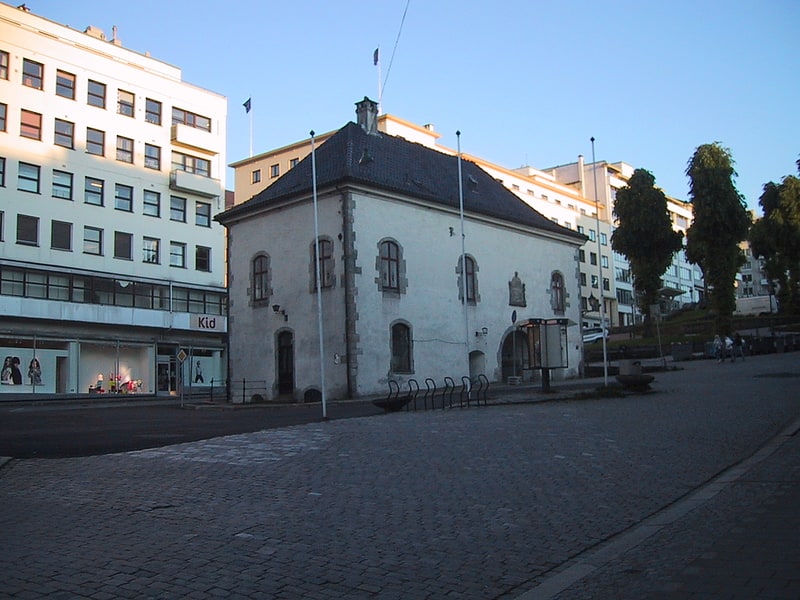
Also known as: Buekorpsmuseet
Museum in Bergen, Norway. The Buekorps Museum is a museum in Bergen, Norway. It is dedicated to the traditional neighborhood youth marching organization, Buekorps.
The Buekorps Museum was established in 1977 and is located in Murhvelvingen on Østre Muralmenning. Murhvelvingen was constructed as a private residence after a great fire disaster in Bergen in 1561. Construction was directed by nobleman Erik Ottesen Rosenkrantz til Arreskov, who was commander Bergenhus from 1560 to 1568. The building was damaged by fires in 1625, 1640, and 1643 and was repaired in 1651–52. The current pavilion was built after the Bergen fire of 1702.[32]
Lyderhorn

Picturesque summit with sea views. Lyderhorn is a mountain in the city of Bergen in Vestland county, Norway. It is one of "De syv fjell", the seven mountains surrounding the city centre, and the starting location of Bergen Turlag's annual trip of the mountains. It is located by Liavatnet approximately 5 kilometres west of the city center. Due to its prominent visibility from the seas, it has historically been a navigational mark for sailors. The 329-metre tall Ørnafjellet is an adjacent peak, and below Ørnafjellet are the two lakes Skåleviksvatnet and Søre Skåleviksvatnet. North of Ørnafjellet is Kvarven fort, a strategic point during World War II, still featuring several bunkers and cannon positions used in the defense of Bergen. Lyderhorn, Ørnafjellet and Kvarven are popular hiking areas.
Folklore has it that Lyderhorn was a gathering location for witches on Midsummer night, Valborg night (the night of May 1), and at Yule.[33]
Siljustøl

Museum in Bergen, Norway. Siljustøl is a museum situated in the borough of Ytrebygda in Bergen, Norway. It was previously the home of composer and musical artist Harald Sæverud and his wife Marie Hvoslef.[34]
Address: Siljustølveien 50, Bergen (Ytrebygda)
Osterøy Bridge
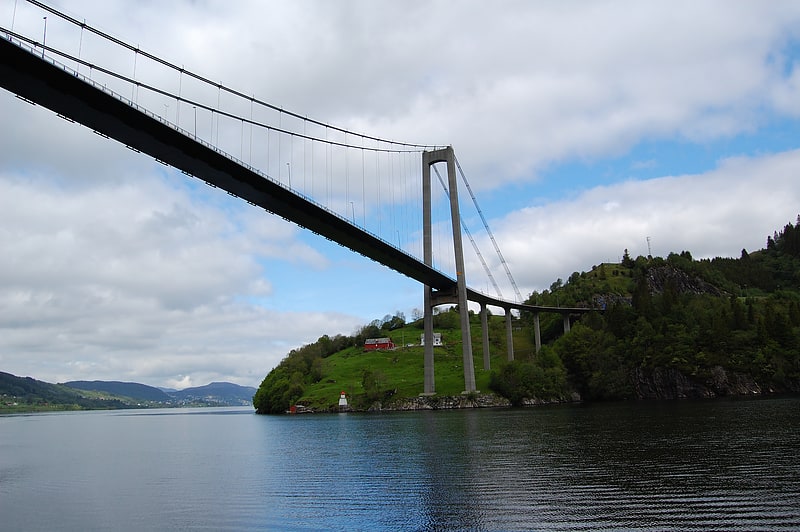
Also known as: Osterøybrua
Suspension bridge in Norway. The Osterøy Bridge is a suspension bridge in Vestland county, Norway. The bridge connects the Kvisti farm area on the island of Osterøy in Osterøy Municipality with the Herland farm area on the mainland in Bergen Municipality east of the city of Bergen. The bridge is the third largest suspension bridge in Norway. It is part of Norwegian County Road 566.
The Osterøy Bridge is a 1,065-metre (3,494 ft) long suspension bridge that has a main span of 595 metres (1,952 ft). There are 8 spans, and none of the piers are in the water, just on land. There is 53 metres (174 ft) of clearance below the bridge. The two suspension towers are each 121.5 metres (399 ft) high. The bridge was completed on 3 October 1997 and cost about 308 million kr. The bridge was designed by the structural engineering firm Aas-Jakobsen.
It was put into service 28 years after the first plans for a connection between Osterøy and Bergen were prepared. It was opened for traffic by Sissel Rønbeck, the Norwegian Minister of Transport and Communications. The bridge was built to withstand quite strong winds. Experts have indicated that the bridge should be capable of surviving an extreme storm. The bridge is tuned so that its greatest oscillation occurs when the wind is about 10 metres per second (22 mph) such as a light breeze.[35]